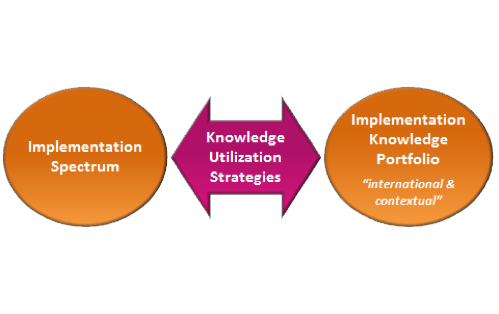Leveraging Change – SISN’s Key Priorities
SISN’s Strategic Plan sets out our conceptual thinking and the steps which we are taking to achieve our vision in support of global and country efforts to scale-up nutrition. Fundamental to this plan are three priority areas for attention: the first is the ‘Implementation Spectrum’ – SISN’s expanded view of what need to be considered in implementation; the second is the ‘Implementation Knowledge Portfolio ‘ – our wider perspective of what kind of knowledge types are of value; and last, but not least, ‘Knowledge Utilization Strategies’ – the vital driver that leverages the first two.
Implementation Spectrum
It is a common view that implementation refers solely to the process of initiating, managing and expanding implementation (as seen in language like ‘rolling out’ and ‘scaling up’ programs). Whilst it is true that this represents the fundamental ‘nuts and bolts’ of on-the-ground implementation, SISN views this as a partial and limiting perspective. Our framework embraces the wider processes and decisions which may compromise the quality, impact and/or sustainability of implementation and identifies a variety of ways to address them, including but not limited to implementation research. These wider decisions and processes include commitment-building, priority-setting, resource mobilization, intervention choices, detailed implementation planning and multi-sectoral coordination – all of which go beyond ‘initiating, managing and expanding’ on-the-ground and all of which could be strengthened through the ‘implementation knowledge portfolio’.
Implementation Knowledge Portfolio
SISN’s expanded view of implementation requires an equally expanded view of the types of knowledge that might support it. We refer to this expanded concept as the ‘Implementation Knowledge Portfolio’. We make deliberate use of the term knowledge, as distinct from evidence, because the latter can limit our thinking into only considering formal scientific data as useful or relevant. In particular, the nutrition community now is acutely aware that nutrition research agendas have focused on ‘what’ (what interventions might be efficacious) and much more research is needed on ‘how’ (how can these be implemented and effective at-scale and in real-world settings).
This distinction is the rationale for implementation science, which WHO has been defined as “the systematic approach to understanding and addressing barriers to effective and quality implementation of health interventions, strategies and policies”.[1] SISN’s framework acknowledges that the knowledge of implementation barriers and ways to address them comes from two sources (international and contextual) and it comes in several distinct forms. This knowledge might be from scientific publications, local or national surveys and capacity assessments, M&E data, stakeholder surveys and more. But importantly, it may also come in the form of practical tools and guidelines, documented good or promising practices and the tacit experiential knowledge of seasoned planners and implementers, as all of these are also forms of knowledge. Each can play important but distinctive roles in understanding and addressing implementation barriers and for that reason all of them are part of the Implementation Knowledge Portfolio. Some of them may help address barriers in one portion of the Implementation Spectrum (e.g., priority setting and choosing interventions), while others may help address barriers on other portions of the spectrum (e.g., coordination or detailed implementation planning). New empirical research (of varying types) is needed in some cases, but in other cases it is more appropriate and efficient to tap into existing knowledge, tools or guidelines. The ‘portfolio’ concept is a constant reminder that this diversity exists and can provide practical ways to address many implementation barriers. In addition, it calls attention to the fact that the production of implementation-relevant knowledge is not the exclusive domain of researchers: implementers also play important roles in that process, and both can play expanded roles in the future.
Knowledge Utilization Strategies
The key to connecting the ‘Implementation Spectrum’ with the ‘Implementation Knowledge Portfolio’ comes in our third priority, ‘Knowledge Utilization Strategies’. Creating effective and efficient access to implementation knowledge is of paramount importance if we are to close the communication gap between knowledge generators, policy makers, planners, implementers and other stakeholders. Likewise, ensuring its appropriate interpretation and utilization in decision making is essential if implementation is to be effective, efficient and sustainable.
A great deal of implementation knowledge already exists, but is located across a large number of institutional spaces and is not readily accessible to country decision makers. One of SISN’s strategic goals is to catalyze and support a global ‘one-stop knowledge hub’ to enable efficient and timely access to implementation-relevant knowledge, complemented with strategies to promote optimal utilization by planners, implementers and other stakeholders at country level. Some strategies under discussion with global organizations include Communities of Practice among researchers and implementers, a responsive consortium of knowledge support specialists to assist countries and the training and support of ‘knowledge brokers’ at country level, among others.
Connecting Knowledge with Action for Impact
SISN’s vision is “a world where actions to improve nutrition are designed and implemented with the best available scientific knowledge and practical experience”. The three components described here are vital to move towards this vision. The ‘Implementation Spectrum’ reminds all stakeholders of the many decisions and processes that may need strengthening; the’ Implementation Knowledge Portfolio’ reminds us that many forms of knowledge are necessary and available; and the ‘Knowledge Utilization Strategies’ remind us that the biggest challenge is to facilitate appropriate utilization. This is a broader, more robust and more scientifically-grounded perspective than ‘evidence-based policy’ and creates important roles for all stakeholders. SISN looks forward to engaging with its broad and inclusive membership to move these components into reality.
For more details on how SISN is supporting change see our Strategic Plan.
[1] WHO/TDR Implementation Research Toolkit, 2014

